follow y/our river lea-minal edges: prompts for transitory states of being
In the autumn of 2022, after four years since our initial meeting at the river Lea Bow Locks where msdm publications studio was situated, hḗrā, tamara and I (paula) embarked on a self-initiated artist residency along the Lea Valley. During this period, we engaged in dialogue with various manifestations of the river Lea, which presented an opportunity for us to explore new research and form connections along the fluid geography of the Lea Valley. Its timeline spans from ancient water sources and industrial waterways to contemporary urban hydro-spectacles, reflecting humanity’s changing relationship with water over time, from a deity to a resource, from common use to private commodity.
Our experience during the residency inspired us to develop hybrid relational methods of portraiture that capture human and non-humans along the river as mobile subjects connected to one another. Hera and I worked on inscribing rituals for transitory states of being into the landscape of the Lower Lea Valley and the traces of the East London Waterworks. Tamara, on the other hand, engaged with people, animals and plant life she encountered along the river, starting at its mouth and following the waters thirty miles north, outside of London.
Through photography and walking along the river, we approached archaeological, ecological, sculptural, and archival sites that the Lea Valley has become, as well as compiling a database of site-specific publishing related to Lea’s life in print since the 19th century. Our efforts resulted in two publications, this one titled ‘follow y/our river lea-minal edges: prompts for transitory states
of being,’ which is an open book to be activated by the reader; and the other, ‘Follow y/our river: a manual for deep mapping in the Lower Lea Valley,’ which is a guide that Tamara and I created for the Photography program at the School of Arts and Creative Industries / London South Bank University where we teach.
Our students were invited to conduct fieldwork along the river Lea using transdisciplinary approaches such as photographic, geographical, ecological, and experiential methods, to develop a narrative about the Lea Valley. Each student engaged in a dialogue with their respective watery places, delving deep into their personal memories and experiences with water, to create visual stories that reflect our evolving relationship with the landscape. These works were first exhibited at Copeland Gallery in December 2022 and subsequently published as photobooks for the Photobook Popup.
This week-long student-run publishing fair coincides with our book launch and exhibition at Borough Road Gallery in May 2023. We have developed an editorial lab for readers to create their own constellation of ‘follow y/our river,’ with an invitation to activate prompts for transitory states of being in the gallery space.
On the wall of msdm studio is an index card with a quote from Joseph Campbell that states, ‘Follow your bliss.’ This quote reminds us of the importance of pursuing what we are passionate about and being on purpose to our community. Campbell’s ideas are relevant to anyone on the path of transformation and self- development, and this project invites you to consider the life-shifting implications of following your bliss too. By connecting to your river, you can recognise that it has been waiting for you all along, and this is the river of your bliss.
We created a new word, lea-minal, by drawing attention to the liminal edges of the river Lea. This term suggests the soft boundaries where materials are in a transformative relationship with each other. These edges are where water and land come together to become an ecological materiality, in which movement and flow, applied to human and non-human bodies of water, can coexist and be embodied in the river and its lea-minal edges.
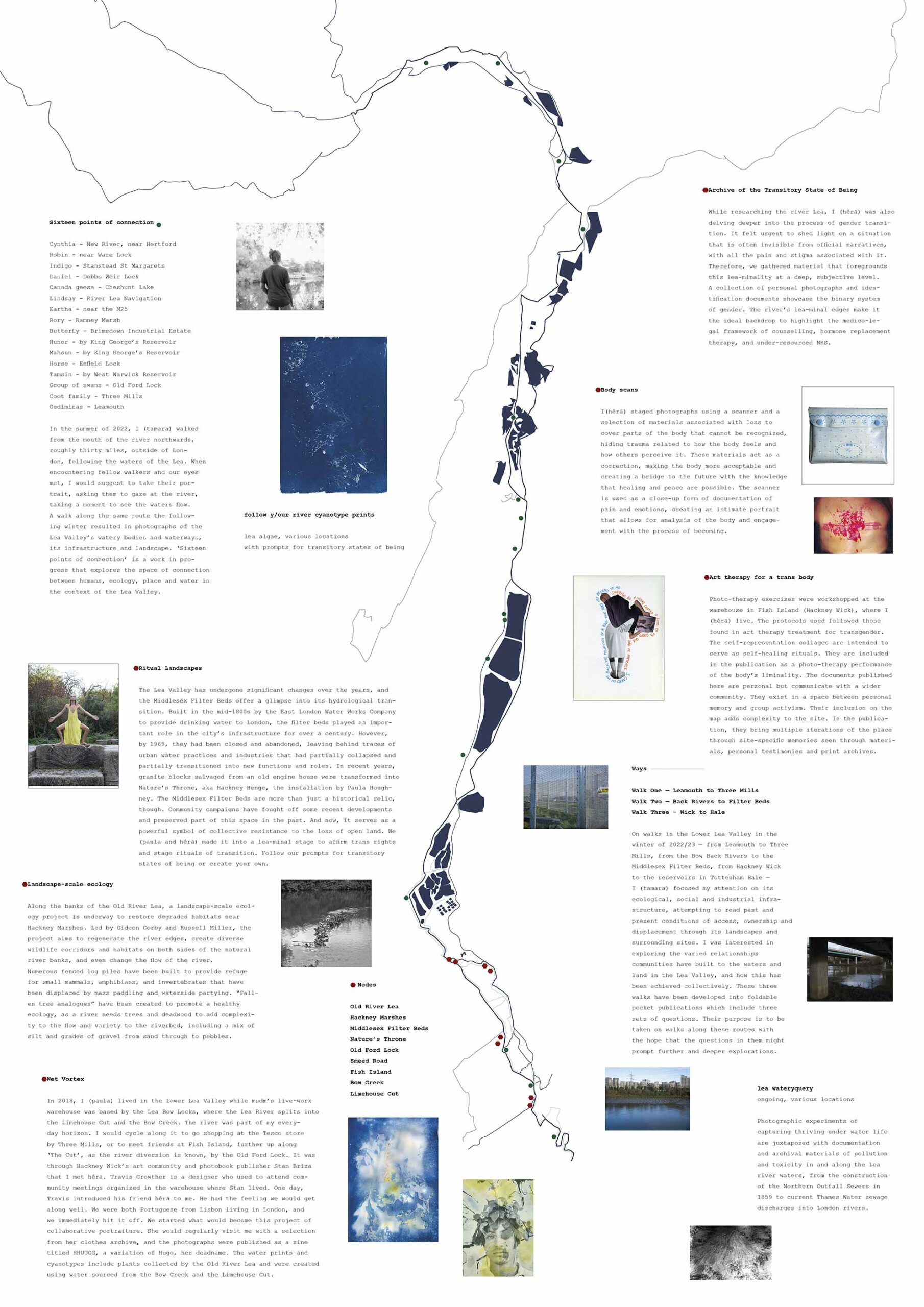
CONTENT
THREE FOLDABLE POCKET BOOKS Three Ways
Walk One — Leamouth to Three Mills
Walk Two — Back Rivers to Filter Beds
Walk Three - Wick to Hale
ONE BOOK Lea wateryquery
various locations
TWO BOOKS Sixteen points of connection
Cynthia and Charley, New River, Hertford
Robin, near Ware Lock
Indigo, Stanstead St Margarets
Daniel, Dobbs Weir Lock
Canada geese, Cheshunt Lake
Lindsay, River Lea Navigation
Eartha, near the M25
Rory, Ramney Marsh
Butterfly, Brimsdown Industrial Estate
Huner, by King George’s Reservoir
Mahsun, by King George’s Reservoir
Horse, Enfield Lock
Tamsin, by West Warwick Reservoir
Group of swans, Old Ford Lock
Coot family, Three Mills
Gediminas, Leamouth
THREE CARDS follow y/our river
cyanotype prints, various locations
19 LOOSE FOLIOS Nine Nodes
Ritual Landscapes
Landscape-scale ecology
Archive of the Transitory State of Being
Art therapy for a trans body
Body scans
Wet vortex
Old River Lea
Middlesex Filter Beds
Nature’s Throne
Hackney Marshes
Old Ford Lock
Smeed Road
Fish Island
Bow Creek
Limehouse Cut
COLOPHON
follow y/our river lea-minal edges:
prompts for transitory states of being
paula roush, tamara stoll and hḗrā santos
ISBN: 978-1-7390996-4-0
Photography and texts: paula roush,
tamara stoll + hḗrā santos
Editorial design: paula roush + tamara stoll
Typesetting: The Modern Designer
Production assistance:
IC Visual Lab
Swap studio
Supported by:
School of Arts and Creative Industries /
Centre for the Study of the Networked Image
at London South Bank University
Publication license:
Creative Commons(CC BY-NC-SA 4.0)
Edition: 100
Published by:
msdm [mobile strategies of display & mediation] publications
+
road less travelled press
msdm.org.uk
Acknowledgements:
Simon Terrill, Gideon Corby (Wildlife Gardeners
of Haggerston), Russell Miller (Tree Musketeers), Simon Myers and Basia Rabczuk (Cody Dock), Aran O’Carroll, Mark McFarlane, Stan Briza, Travis Crowther, Maja Ngom.
hḗrā clothes archive: yellow dress and scarf from Beyond Retro, Dalston; leather coat with lamb fur, present from dad to mom; Chopova Lowena blouse AW21 with Noir Kei Niomiya AW21 skirt, both from Dover Street Market; orange hand made dress by my dearest friend Claudí.
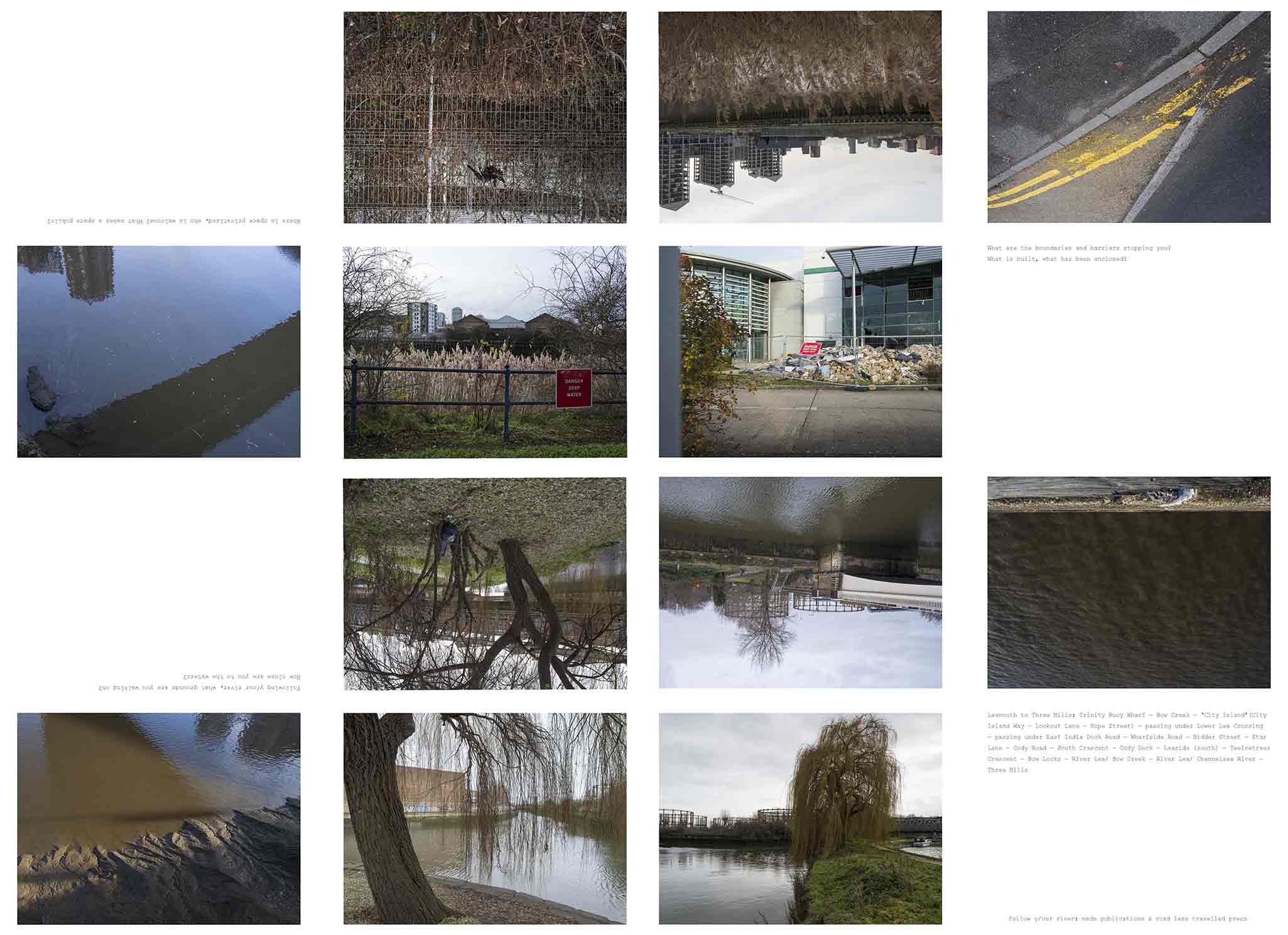
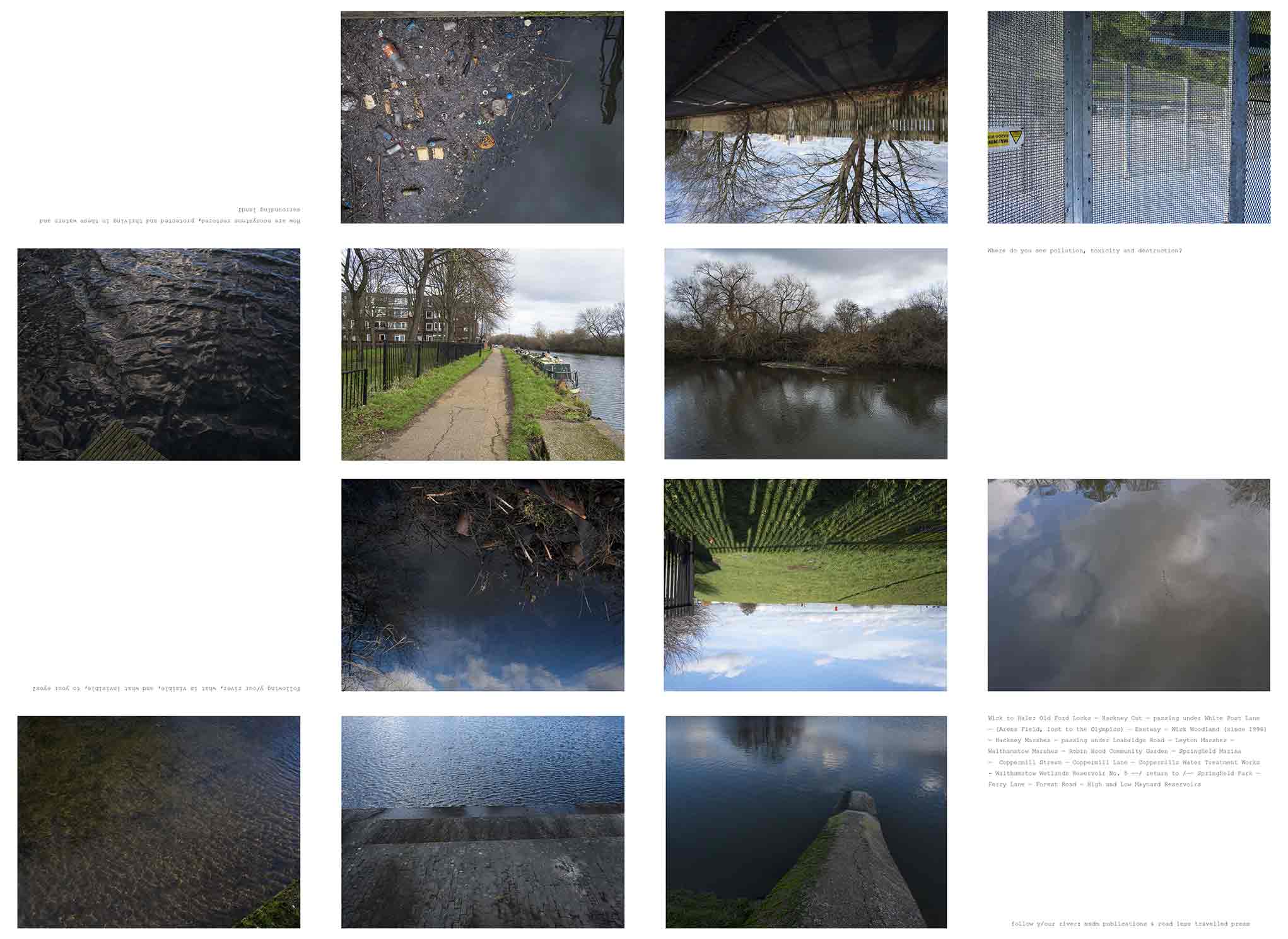
Ways
Walk One — Leamouth to Three Mills
Walk Two — Back Rivers to Filter Beds
Walk Three - Wick to Hale
On walks in the Lower Lea Valley in the winter of 2022/23 —
from Leamouth to Three Mills, from the Bow Back Rivers
to the Middlesex Filter Beds, from Hackney Wick to the
reservoirs in Tottenham Hale — I (tamara) focused my attention
on its ecological, social and industrial infrastructure, attempting to read past and present conditions of access, ownership and displacement through its landscapes and surrounding sites. I was interested in exploring the varied relationships communities have built to the waters and land in the Lea Valley, and how this has been achieved collectively. These three walks have been developed into foldable pocket publications which include three sets of questions. Their purpose is to be taken on walks along these routes with the hope that the questions in them might prompt further and deeper explorations.
The posters have prompts printed on them.
Poster Walk One — Leamouth to Three Mills:
"Following y/our river, what grounds are you walking on? How close are you to the waters"
"Where is space privatised, who is welcome? What makes a space public?"
"What are the boundaries and barriers stopping you? What is built, what has been enclosed?"
Poster Walk Two — Back Rivers to Filter Beds
"How have these waters been contested?"
"How has displacement been resisted? Where is collectivity
taking place?"
"Following y/our river, what can you learn about its past?"
Poster Walk Three — Wick to Hale
"Following y/our river, what is visible, and what is invisible to your eyes?"
"Where do you see pollution, toxicity and destruction?"
"How are ecosystems restored, protected and thriving in these waters and surrounding land?"
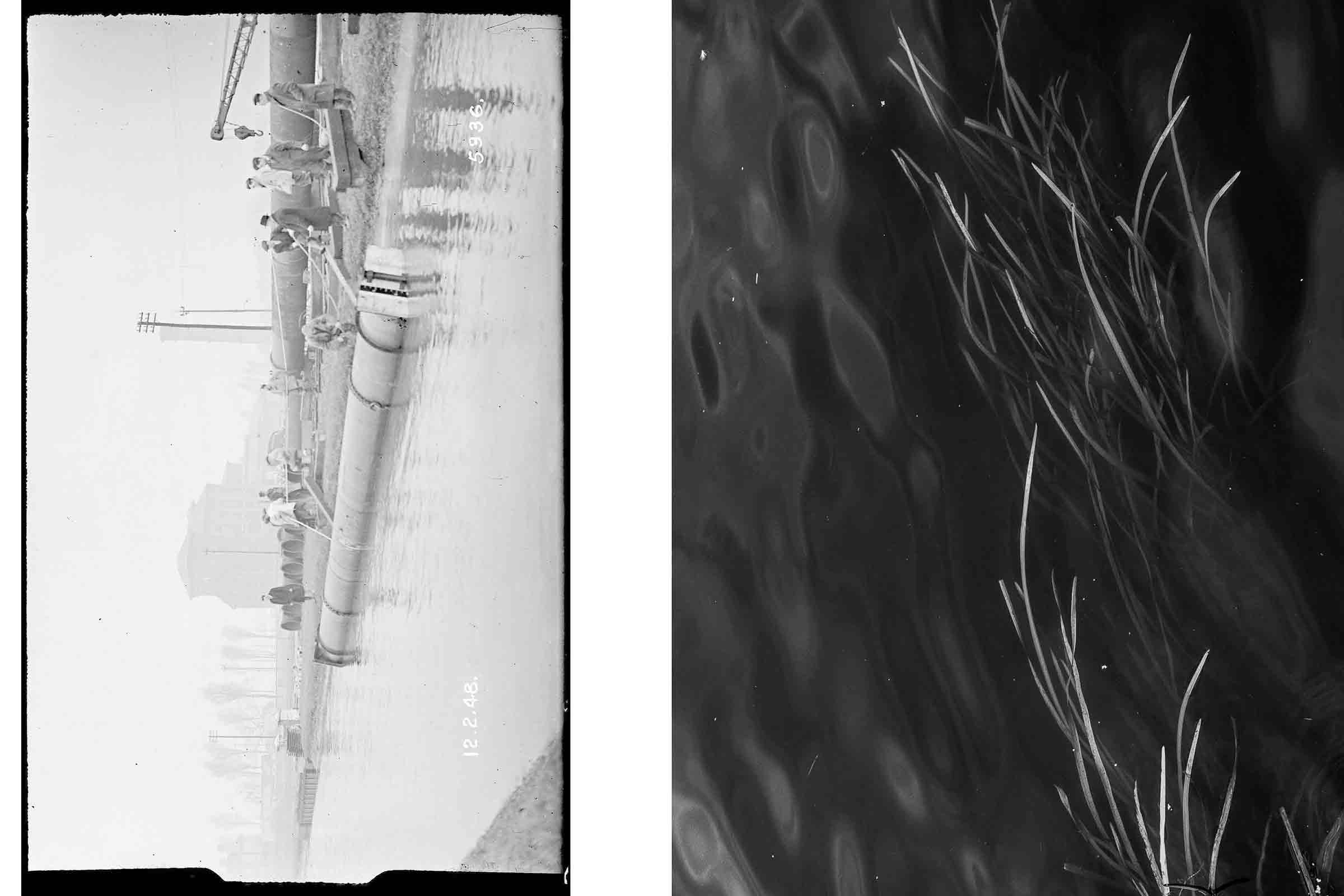
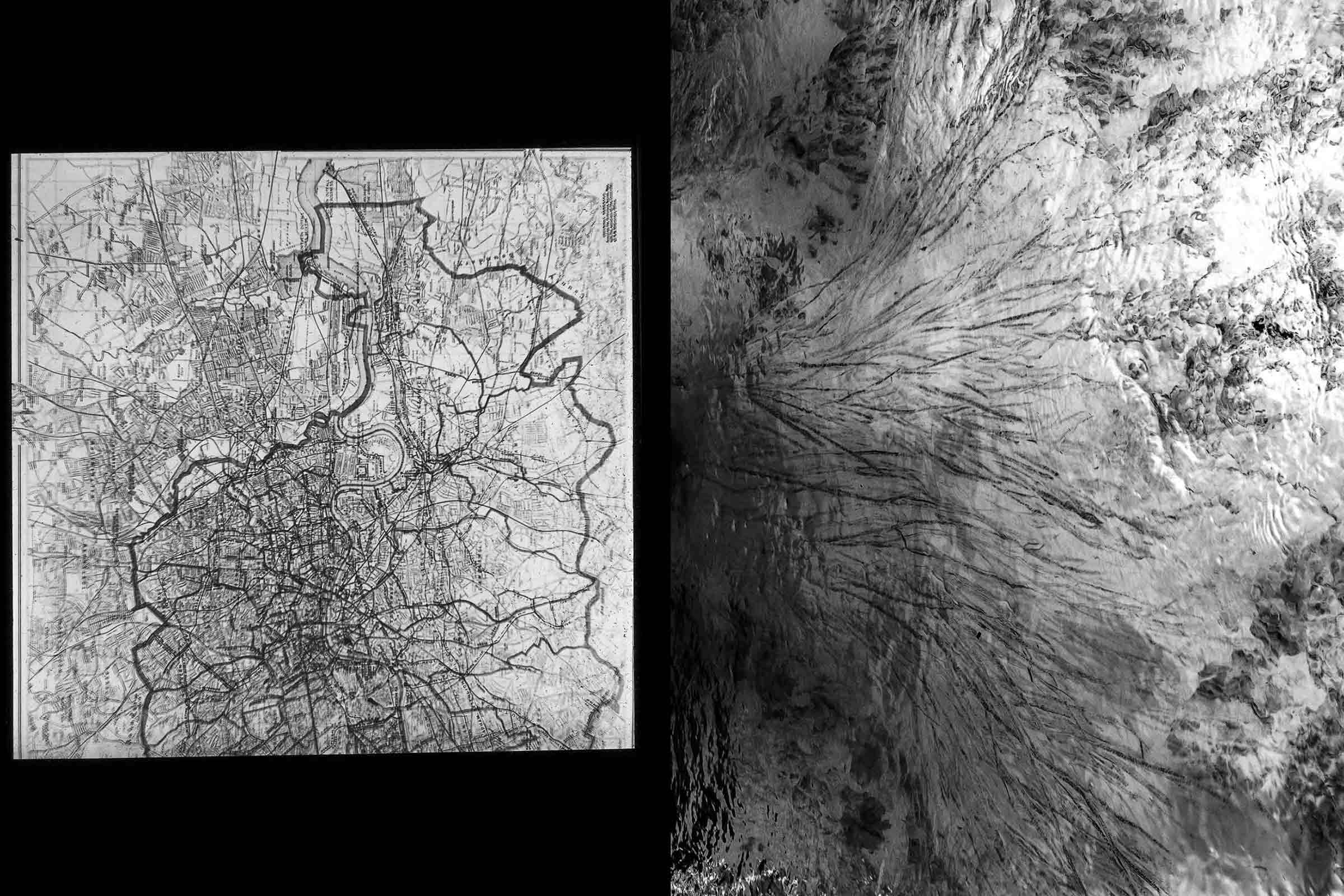
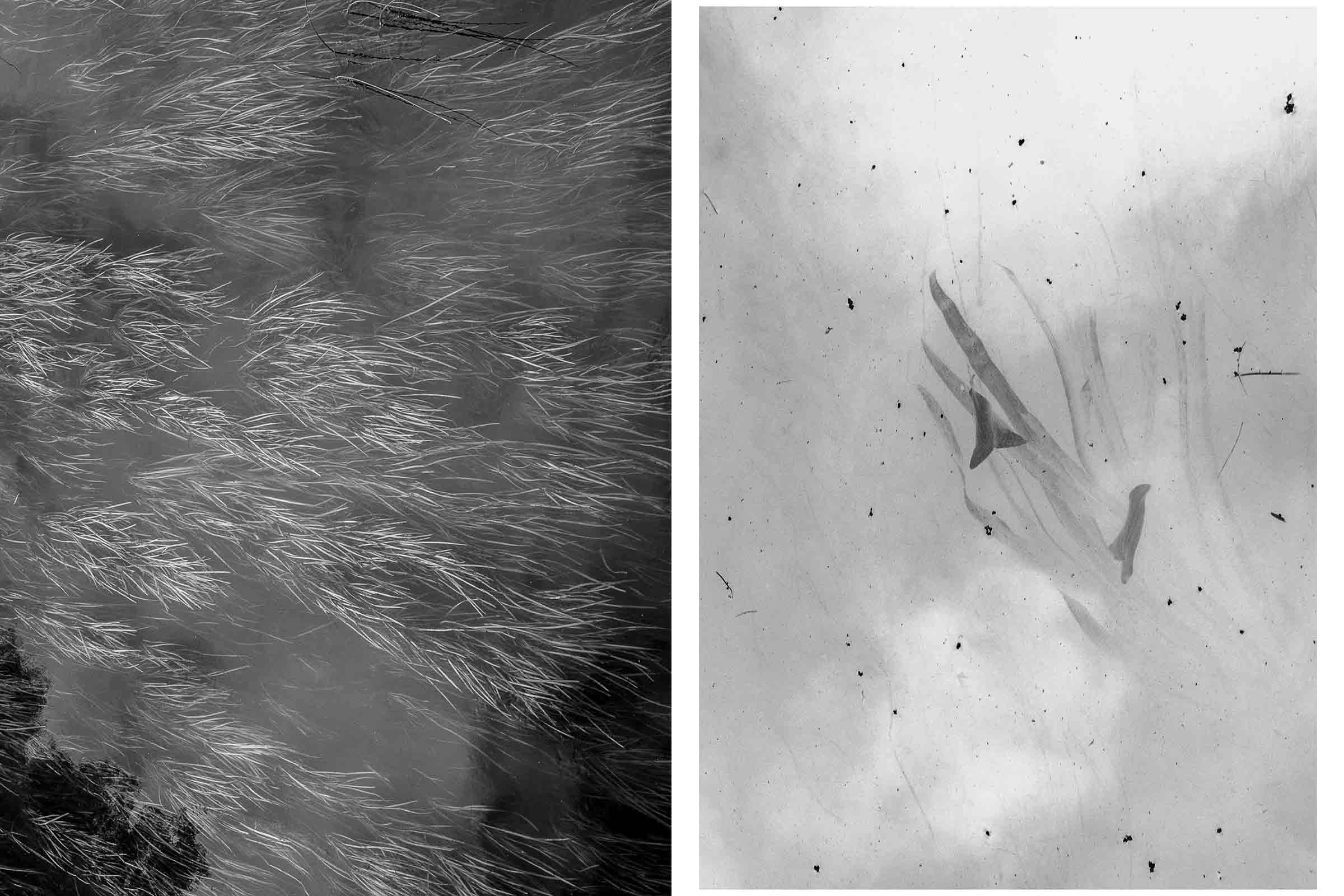
lea wateryquery
ongoing, various locations
Photographic experiments of capturing thriving under water life
are juxtaposed with documentation and archival materials of pollution and toxicity in and along the Lea river waters, from the construction of the Northern Outfall Sewers in 1859 to current Thames Water sewage discharges into London rivers.
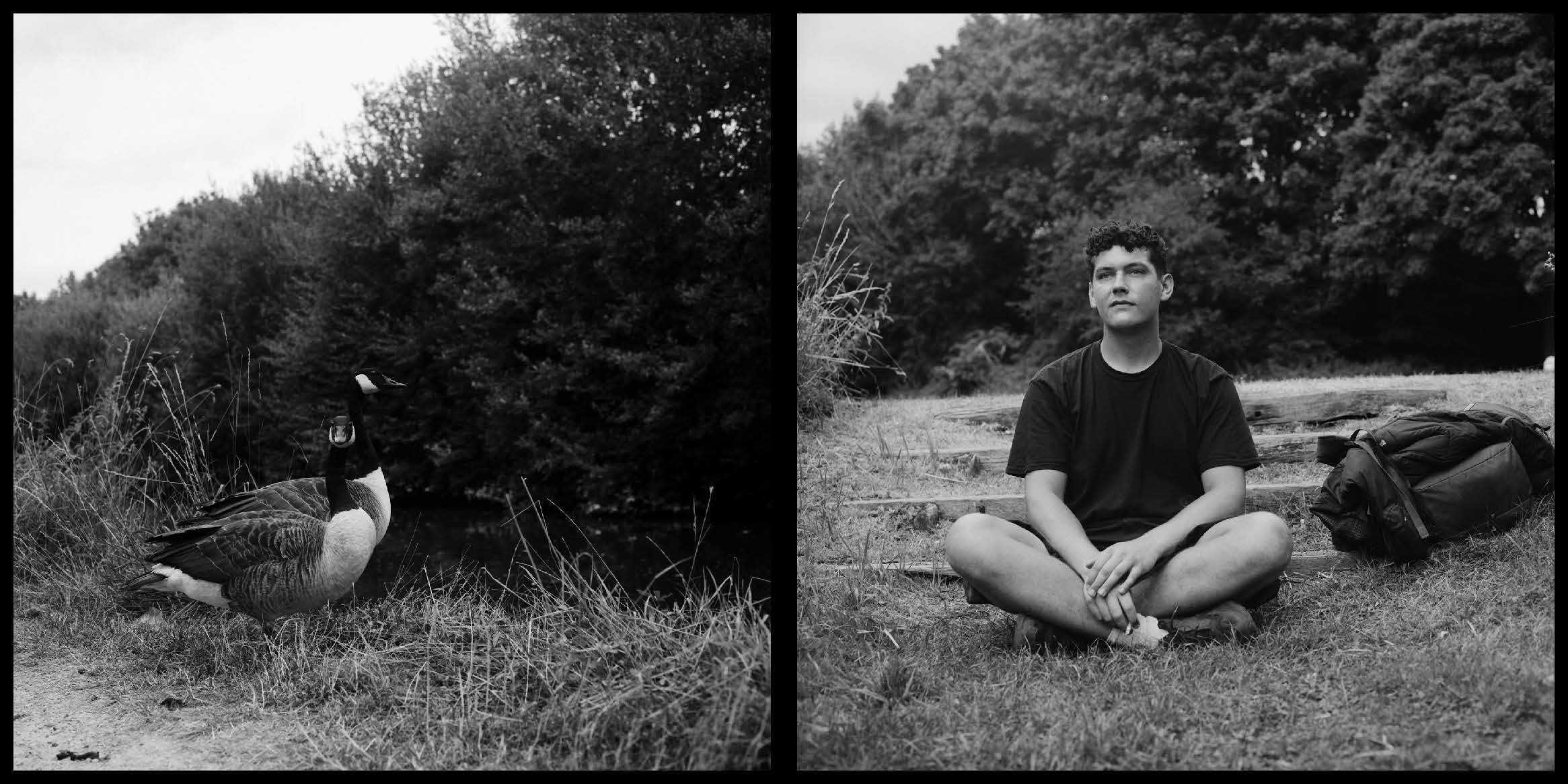
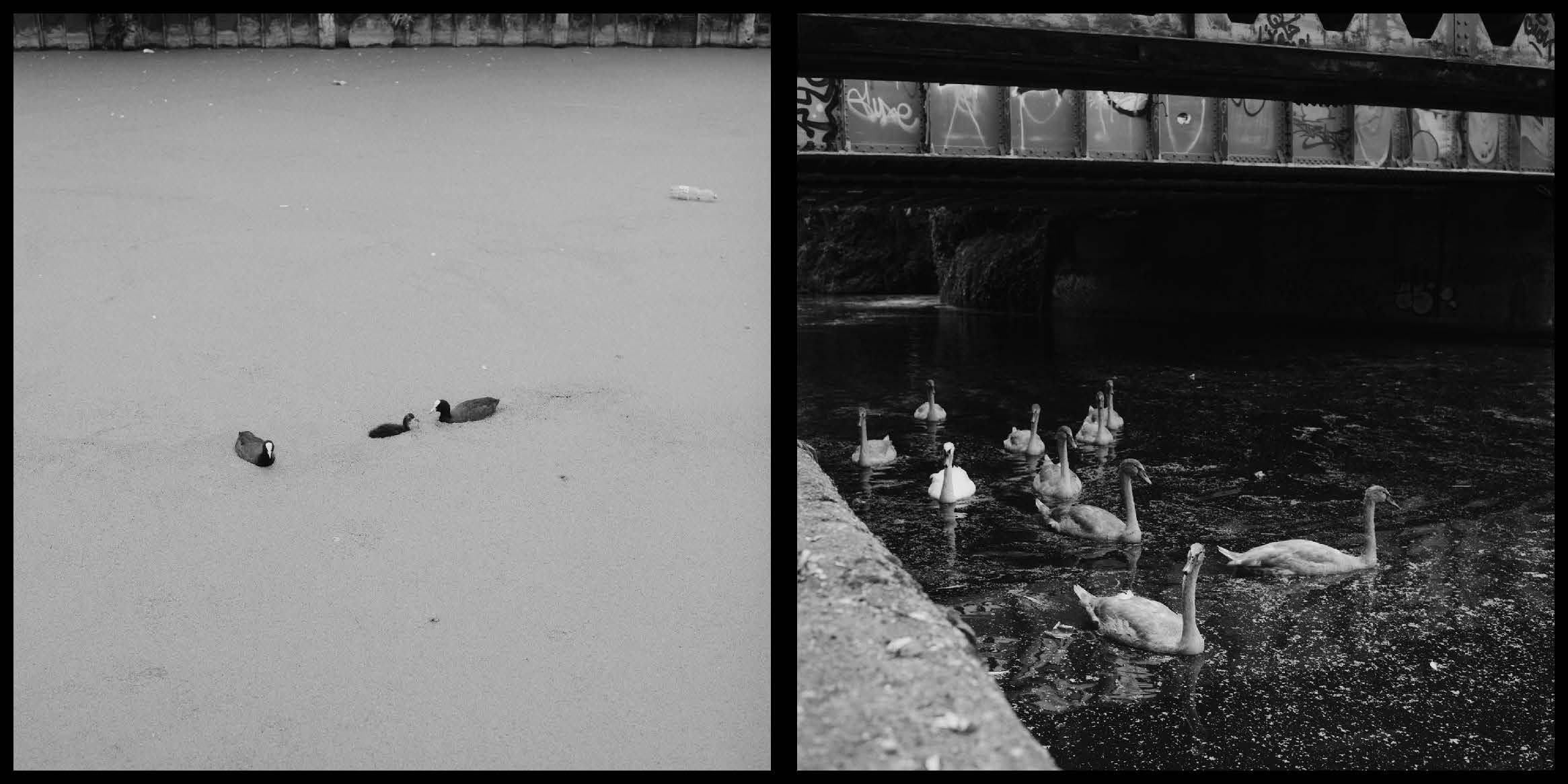
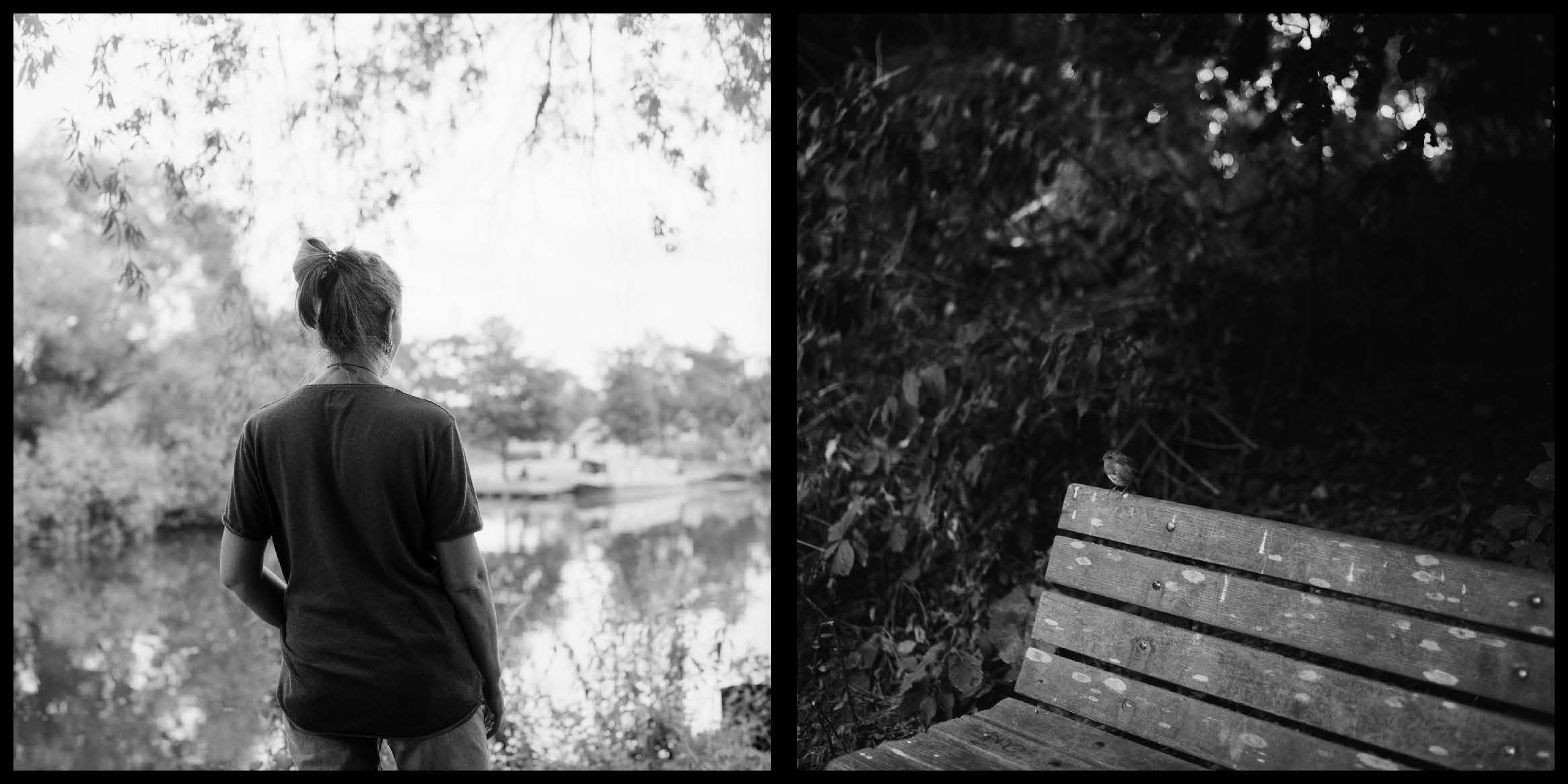
Sixteen points of connection
Cynthia and Charley - New River, Hertford
Robin - near Ware Lock
Indigo - Stanstead St Margarets
Daniel - Dobbs Weir Lock
Canada geese - Cheshunt Lake
Lindsay - River Lea Navigation
Eartha - near the M25
Rory - Ramney Marsh
Butterfly - Brimsdown Industrial Estate
Huner - by King George’s Reservoir
Mahsun - by King George’s Reservoir
Horse - Enfield Lock
Tamsin - by West Warwick Reservoir
Group of swans - Old Ford Lock
Coot family - Three Mills
Gediminas - Leamouth
In the summer of 2022, I (tamara) walked from the mouth of the river northwards, roughly thirty miles, outside of London, following the waters of the Lea. When encountering fellow walkers and our eyes met, I would suggest to take their portrait, asking them to gaze at the river, taking a moment to see the waters flow. A walk along the same route the following winter resulted in photographs of the Lea Valley’s watery bodies and waterways, its infrastructure and landscape. ‘Sixteen points of connection’ is a work in progress that explores the space of connection between humans, ecology, place and water in the context of the Lea Valley.
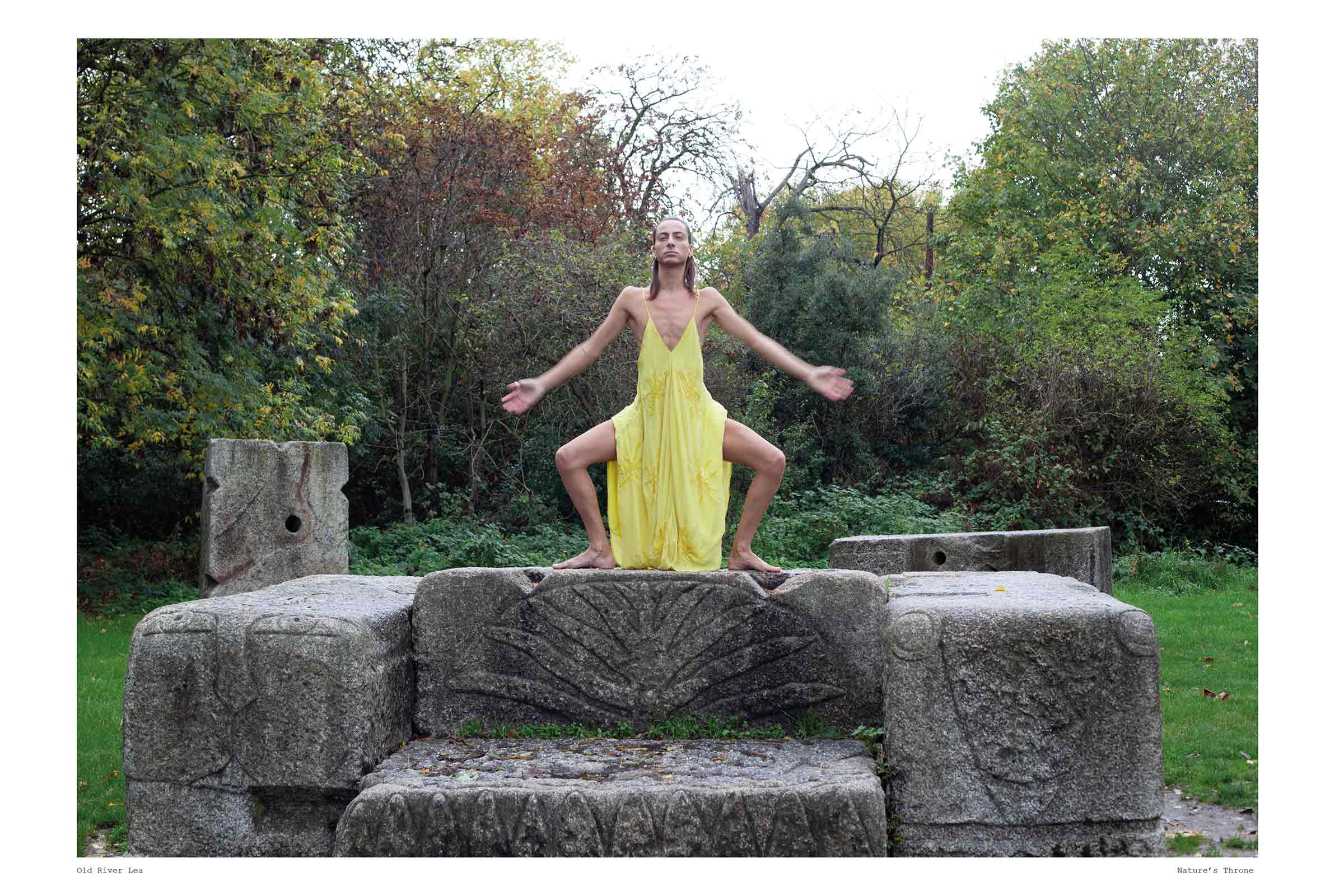
Ritual Landscapes
The Lea Valley has undergone significant changes over the years, and the Middlesex Filter Beds offer a glimpse into its hydrological transition. Built in the mid-1800s by the East London Water Works Company to provide drinking water to London, the filter beds played an important role in the city’s infrastructure for over a century. However, by 1969, they had been closed and abandoned, leaving behind traces of urban water practices and industries that had partially collapsed and partially transitioned into new functions and roles. In recent years, granite blocks salvaged from an old engine house were transformed into Nature’s Throne, aka Hackney Henge, the installation by Paula Houghney.
The Middlesex Filter Beds are more than just a historical relic, though. Community campaigns have fought off some recent developments and preserved part of this space in the past. And now, it serves as a powerful symbol of collective resistance to the loss of open land. We (paula and hḗrā) made it into a lea-minal stage to affirm trans rights and stage rituals of transition. Follow our prompts for transitory states of being or create your own.
Paisagens Rituais
O Vale do Lea passou por mudanças significativas ao longo dos anos, e os Middlesex Filter Beds oferecem um vislumbre de sua transição hidrológica. Construídos em meados do século XIX pela East London Water Works Company para fornecer água potável a Londres, os leitos de filtragem desempenharam um papel importante na infraestrutura da cidade por mais de um século. No entanto, em 1969, foram fechados e abandonados, deixando para trás vestígios das práticas e indústrias urbanas de água que colapsaram e parcialmente se transformaram em novas funções e papéis. Nos últimos anos, blocos de granito recuperados de uma antiga casa de máquinas foram transformados no "Trono da Natureza", também conhecido como "Hackney Henge", a instalação de Paula Houghney.
Os Middlesex Filter Beds são mais do que apenas uma relíquia histórica. Campanhas comunitárias têm combatido alguns desenvolvimentos recentes e preservado parte deste espaço no passado. E agora, serve como um poderoso símbolo de resistência coletiva à perda de terras abertas. Nós (paula e hḗrā) transformamos o local em um palco lea-minal para afirmar os direitos trans e encenar rituais de transição. Siga nossos prompts para estados transitórios de ser ou crie os seus próprios.
PROMPTS FOR TRANSITORY STATES OF BEING
three cards of cyanotype prints with prompts for transitory states of being
Follow y/our river towards a specific transition you have in mind for yourself. Visualise a bridge that connects your current self to the self that has achieved that transition. Allow yourself to embody this journey as you move across the bridge, becoming fully present in the moment of transformation.
Follow y/our river towards a safe place where you can experience compassion. Allow yourself to be immersed in the feeling of compassion towards yourself, and feel it flowing outwards to others. Let the current of y/our river carry you towards a state of empathy and connection.
Follow y/our river towards the liminal edges of consciousness. Visualise yourself entering a transitory state of being, where the boundaries between the human and the non-human begin to dissolve. Allow yourself to be fully present in this state, sensing the materiality of water as it flows within and around you.
INSTRUÇÕES PARA ESTADOS DE SER TRANSITÓRIOS
Três cartões de impressões em cianotipia com instruções para estados de ser transitórios
Siga o v/nosso rio em direção a uma transição específica que tenha em mente para si mesma. Visualize uma ponte que conecta seu eu atual ao eu que alcançou essa transição. Permita-se incorporar essa jornada enquanto atravessa a ponte, tornando-se totalmente presente no momento da transformação.
Siga o v/nosso rio em direção a um lugar seguro onde possa experimentar compaixão. Permita-se ser imerso no sentimento de compaixão por si mesma e sinta-o fluindo para os outros. Deixe a corrente do v/nosso rio levar você para um estado de empatia e conexão.
Siga o v/nosso rio em direção às margens liminares da consciência. Visualize-se entrando num estado transitório de ser, onde as fronteiras entre o humano e o não-humano começam a se dissolver. Permita-se estar totalmente presente nesse estado, percebendo a materialidade da água enquanto ela flui dentro e ao seu redor.
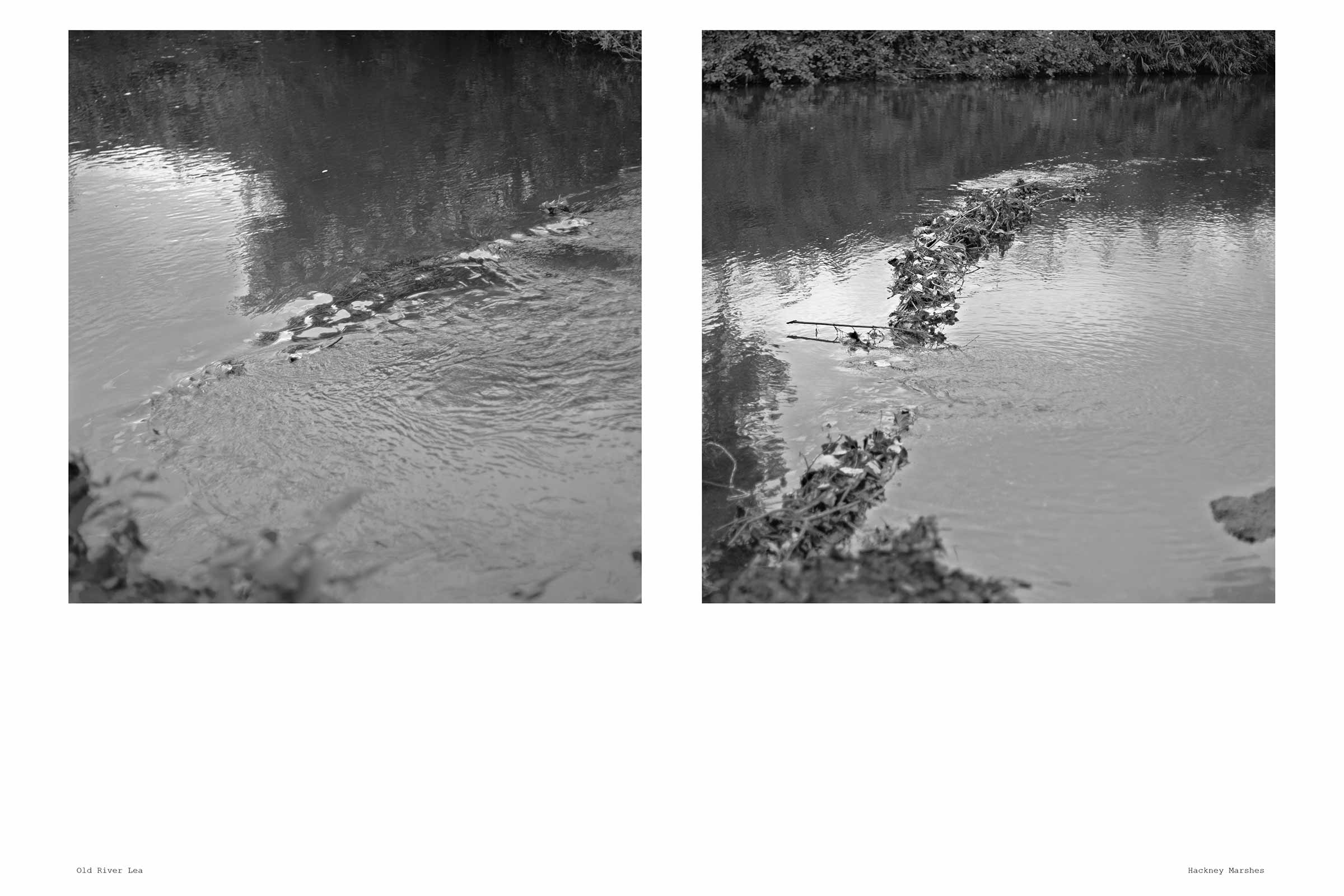
Landscape-scale ecology
Along the banks of the Old River Lea, a landscape-scale ecology project is underway to restore degraded habitats near Hackney Marshes. Led by Gideon Corby and Russell Miller, the project aims to regenerate the river edges, create diverse wildlife corridors and habitats on both sides of the natural river banks, and even change the flow of the river.
Numerous fenced log piles have been built to provide refuge for small mammals, amphibians, and invertebrates that have been displaced by mass paddling and waterside partying. “Fallen tree analogues” have been created to promote a healthy ecology, as a river needs trees and deadwood to add complexity to the flow and variety to the riverbed, including a mix of silt and grades of gravel from sand through to pebbles.
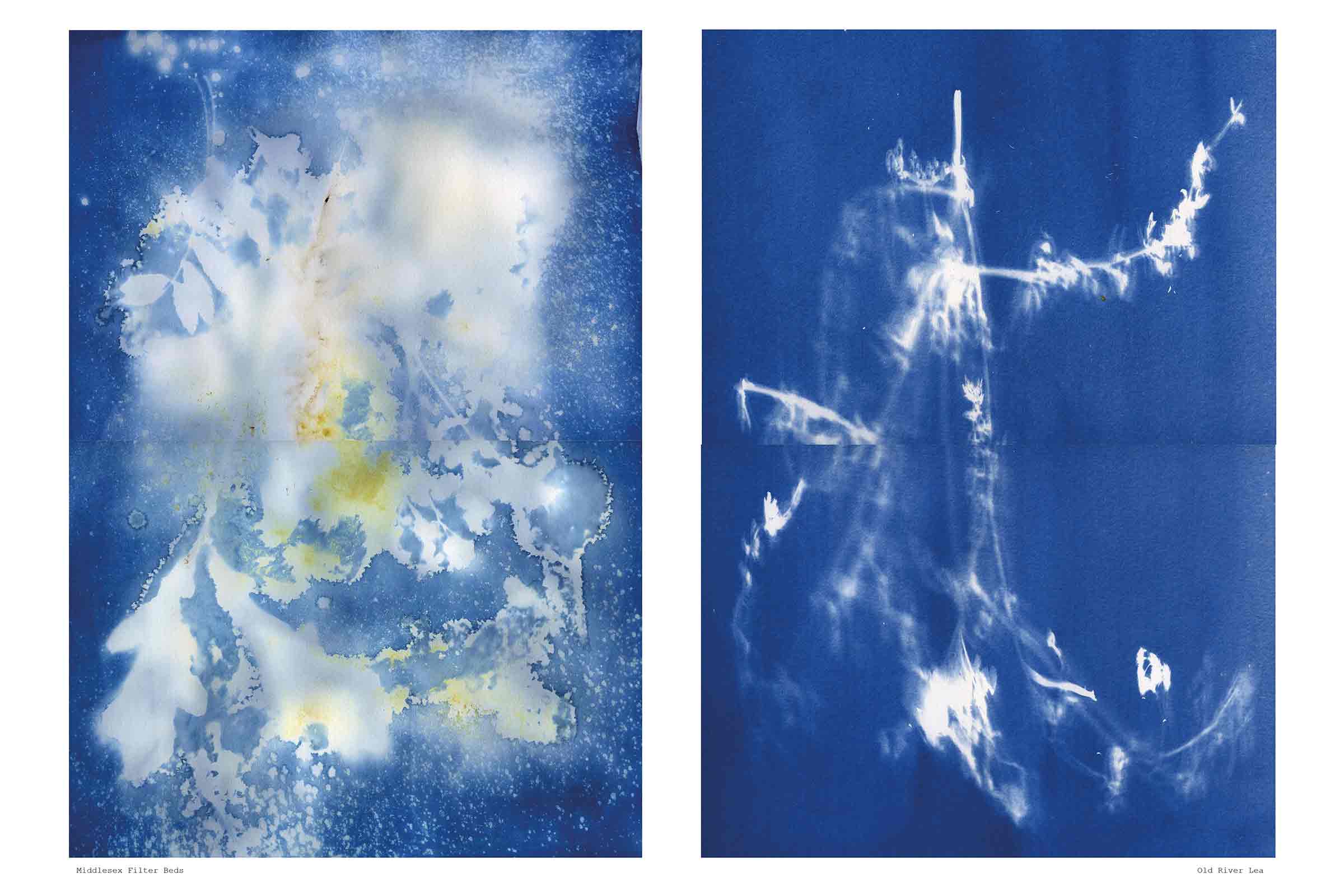
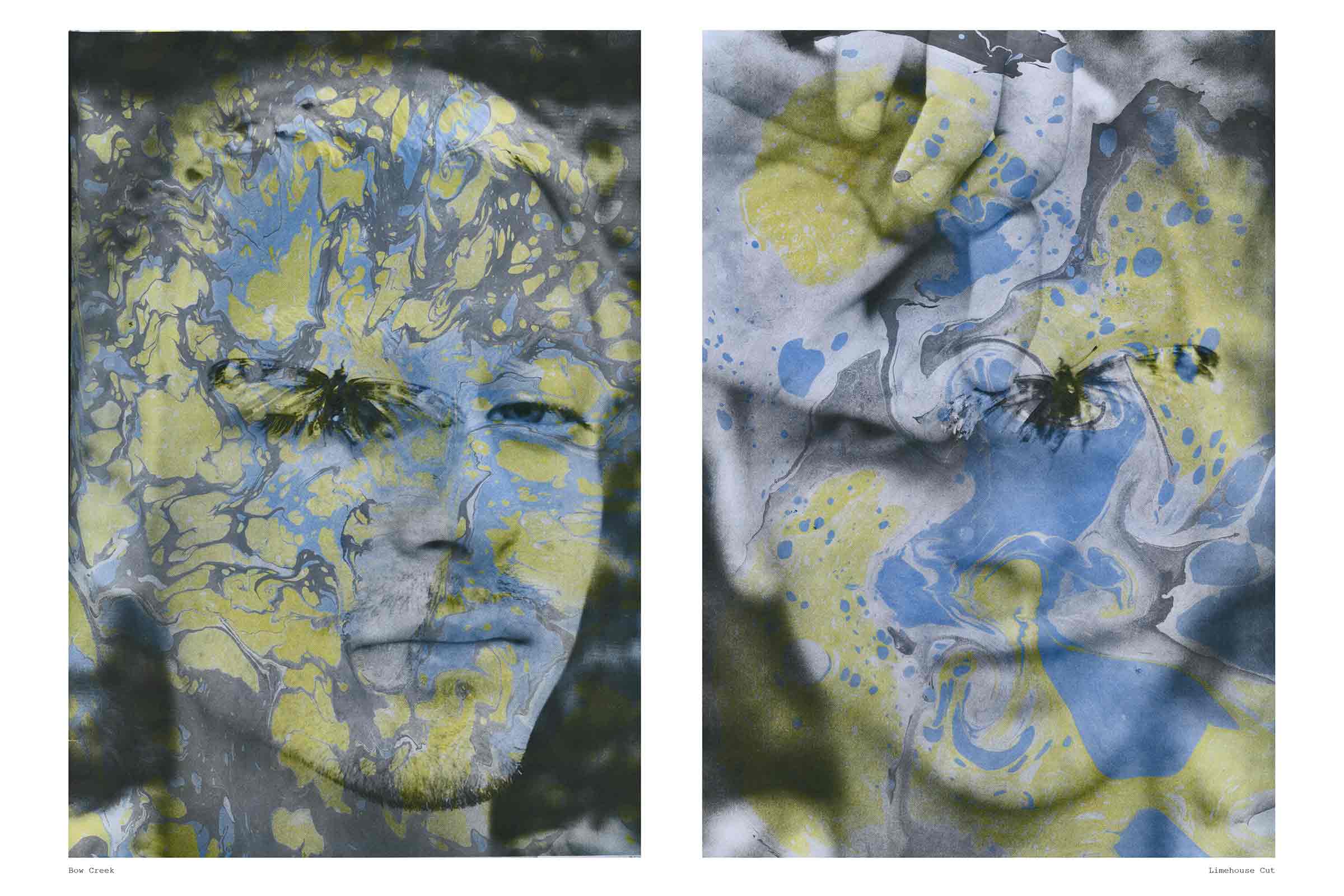
Wet Vortex
In 2018, I (paula) lived in the Lower Lea Valley while msdm’s live-work warehouse was based by the Lea Bow Locks, where the Lea River splits into the Limehouse Cut and the Bow Creek. The river was part of my everyday horizon. I would cycle along it to go shopping at the Tesco store by Three Mills, or to meet friends at Fish Island, further up along ‘The Cut’, as the river diversion is known, by the Old Ford Lock. It was through Hackney Wick’s art community that hḗrā and I met. Both Travis Crowther and I used to attend creatives’ meetups organised in the warehouse where photobook publisher Stan Briza lived. One day, Travis introduced his friend hḗrā to me. He had the feeling we would get along well. We were both Portuguese from Lisbon living in London, and we immediately hit it off. We started what would become this project of collaborative portraiture. She would regularly visit me with a selection from her clothes archive, and the photographs were published as a zine titled HHUUGG, a variation of Hugo, her deadname. The water prints and cyanotypes include plants collected by the Old River Lea and were created using water sourced from the Bow Creek and the Limehouse Cut.
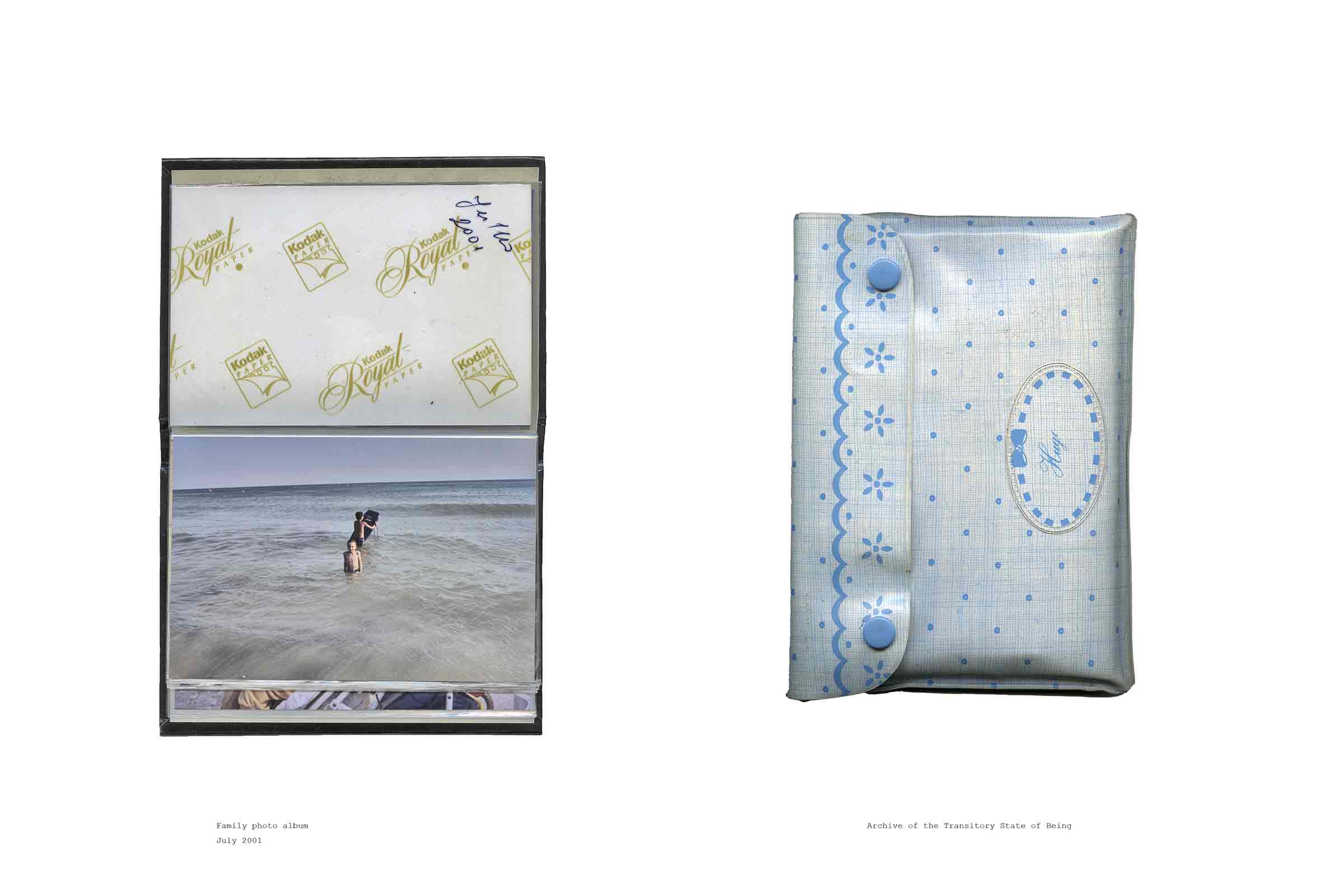
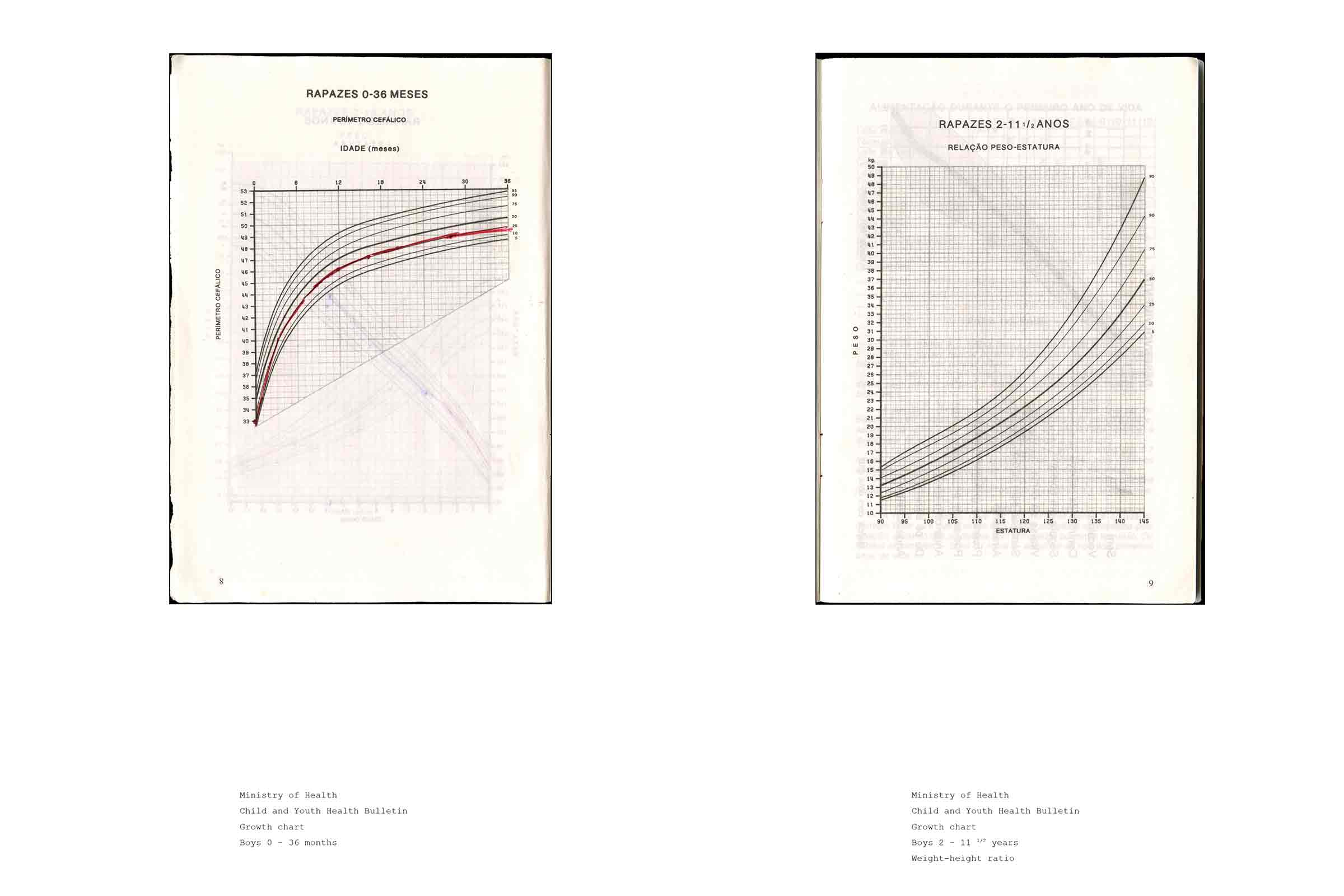
Archive of the Transitory State of Being
While researching the river Lea, I (hḗrā) was also delving deeper into the process of gender transition. It felt urgent to shed light on a situation that is often invisible from official narratives, with all the pain and stigma associated with it. Therefore, we gathered material that foregrounds this lea-minality at a deep, subjective level.
A collection of personal photographs and identification documents showcase the binary system of gender, the medico-legal framework of counselling, hormone replacement therapy, and under-resourced NHS.
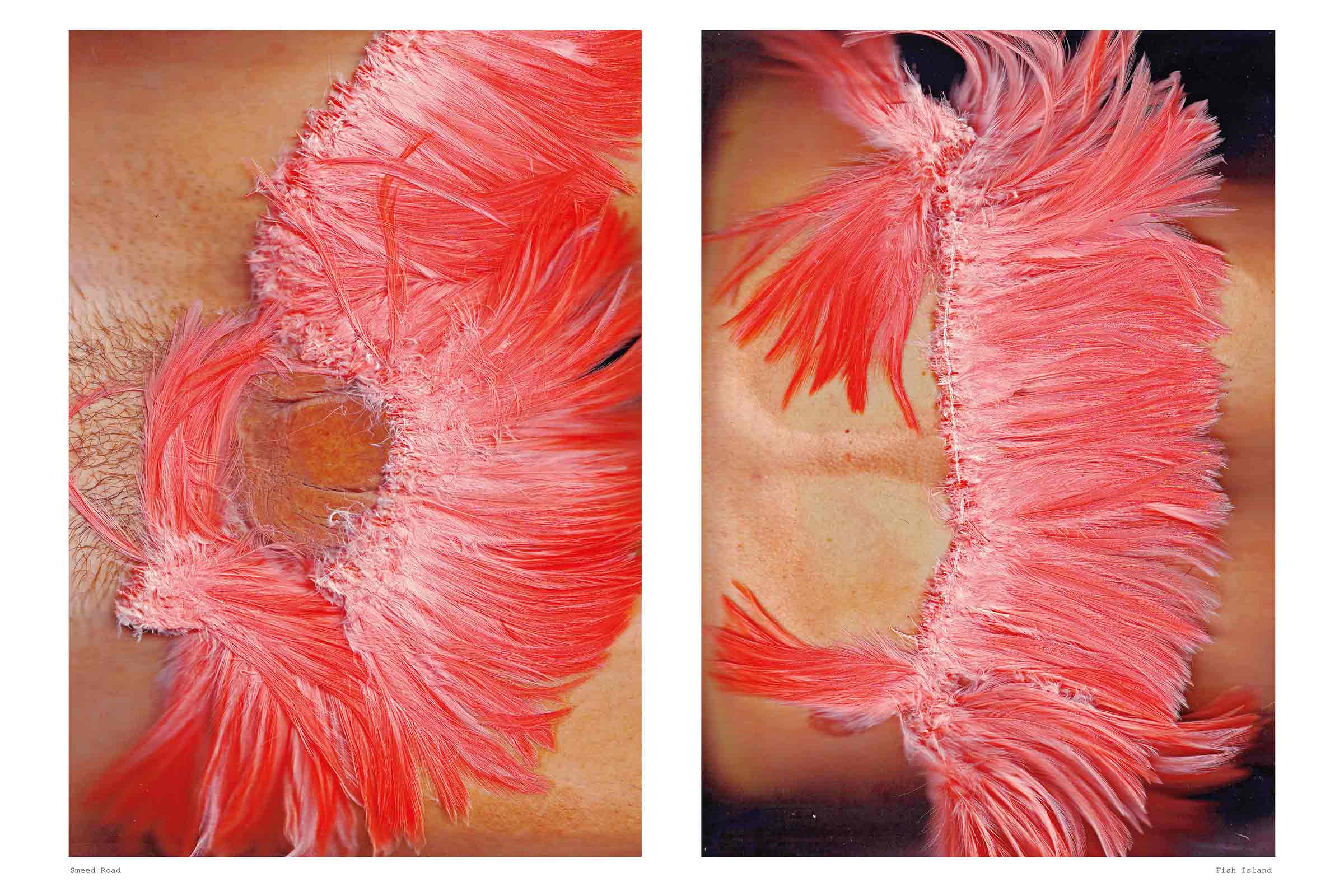
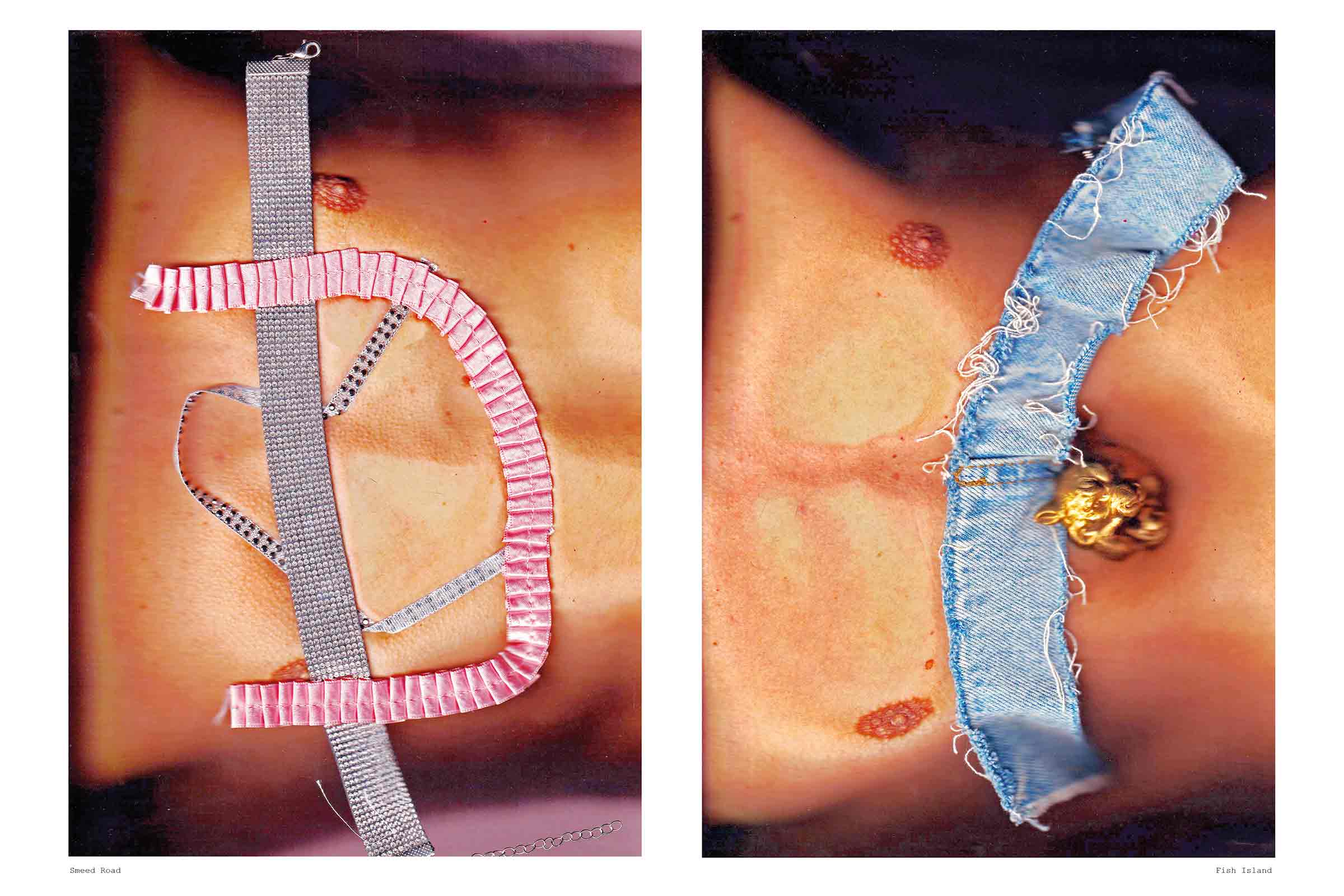
Body scans
I (hḗrā) staged photographs using a scanner and a selection of materials associated with loss to cover parts of the body that cannot be recognized, hiding trauma related to how the body feels and how others perceive it. These materials act as a correction, making the body more acceptable and creating a bridge to the future with the knowledge that healing and peace are possible. The scanner is used as a close-up form of documentation of pain and emotions, creating an intimate portrait that allows for analysis of the body and engagement with the process
of becoming.
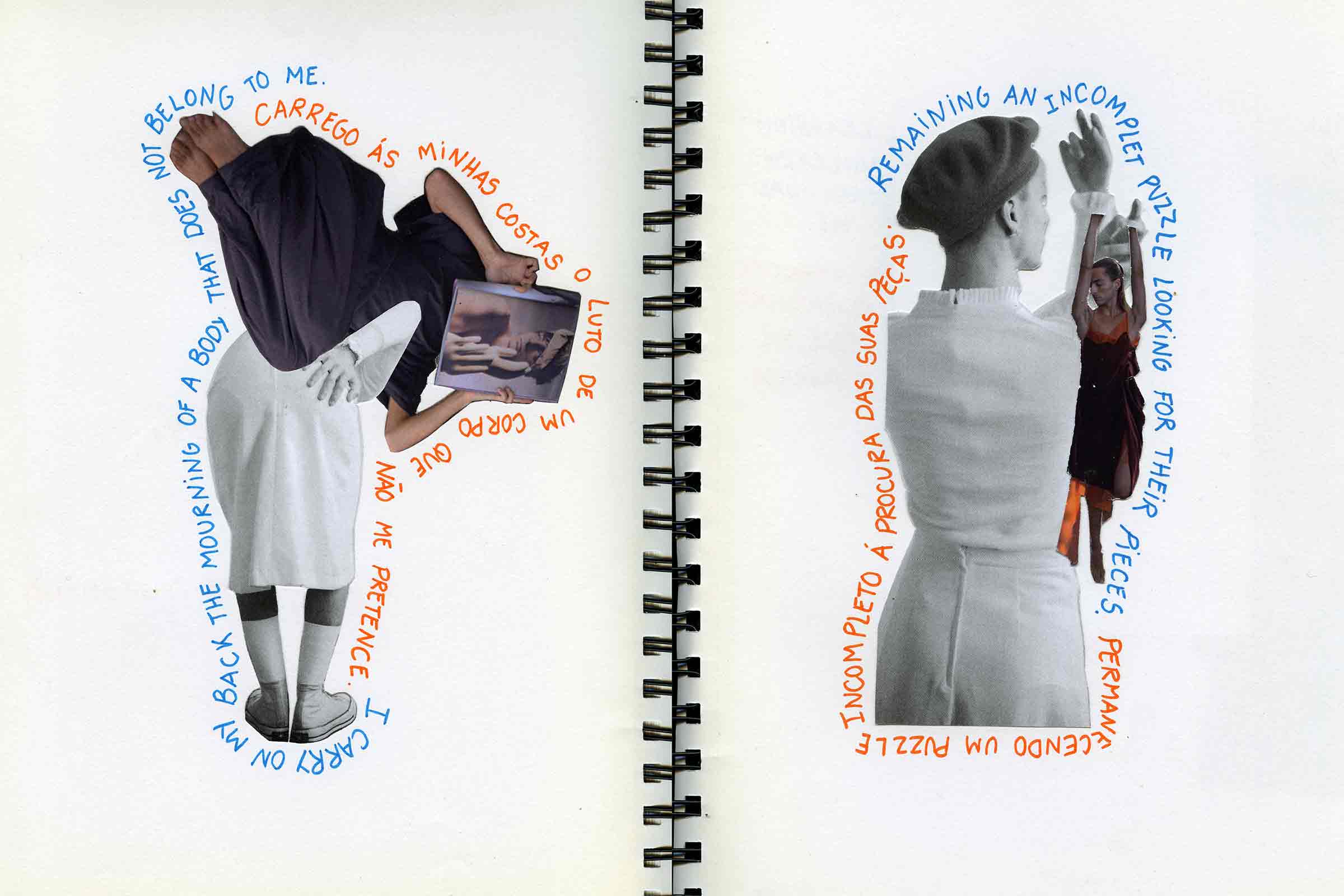
Art therapy for a trans body
Photo-therapy exercises were workshopped at the warehouse in Fish Island (Hackney Wick), where I (hḗrā) live. The protocols used followed those found in art therapy treatment for transgender.
The self-representation collages are intended to serve as self-healing rituals. They are included in the publication as a photo-therapy performance of the body’s lea-minality.
The documents published here are personal but communicate with a wider community. They exist in a space between personal memory and group activism. Their inclusion on the map adds complexity to the site. In the publication, they bring multiple iterations of the place through site-specific memories seen through materials, personal testimonies and print archives.
contact
paula roush ::: paularoush@gmail.com
msdm studio ::: msdm@msdm.org.uk